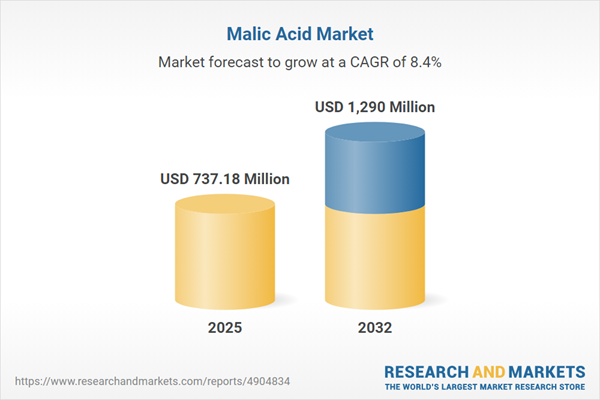Speak directly to the analyst to clarify any post sales queries you may have.
Senior leaders navigating the complexities of procurement are prioritizing agile strategies and robust supply chain management. This malic acid market report streamlines essential market intelligence, empowering informed decisions for organizations operating across diverse and regulated industries.
Market Snapshot: Strategic Growth and Outlook in the Malic Acid Market
The malic acid market is experiencing steady expansion, driven predominantly by its growing application across food and beverage manufacturing, pharmaceuticals, cosmetics, and industrial processes. Current market valuation highlights robust sector momentum, with projections indicating sustained advancement at a healthy compound annual growth rate. Suppliers are focusing on greater efficiency and sustainable sourcing, aligning their product portfolios with evolving industry needs and best practices. As global frameworks shift, organizations are intensifying supply chain compliance and fortifying overall resilience to ensure a competitive edge and business stability.
Scope & Segmentation of the Malic Acid Market
- Grade: Food grade ensures product safety in consumer industries, industrial grade optimizes chemical manufacturing, and pharmaceutical grade maintains quality for healthcare sectors.
- Form: Powder is favored where process accuracy is vital, while liquid form streamlines continuous production and supports cosmetic applications.
- Application: Enhances texture in cosmetics, stabilizes flavors for food and beverages, and increases efficiency across textile, leather, and pharmaceutical manufacturing.
- Distribution Channel: Direct supplier contracts, third-party distributors, retail channels, and digital procurement platforms provide organizations with sourcing flexibility and resilience.
- Regions: Active markets span the Americas, Europe, Middle East, Africa, and Asia-Pacific. Influential countries including the United States, Germany, China, and India drive quality standards and shape supplier strategies.
- Companies Profiled: Major suppliers such as Bartek Ingredients Inc., Junsei Chemical Co., Ltd., Polynt S.p.A., Kanto Chemical Co., Inc., Thirumalai Chemicals Ltd., Muby Chemicals, Ingreland Limited, and Fuso Chemical Co., Ltd. are adapting to regulatory changes and strengthening their market resilience.
Key Takeaways for Senior Leaders
- Integrating malic acid into procurement initiatives enables organizations to respond swiftly to sector change and evolving compliance requirements.
- Precision fermentation and green chemistry initiatives are advancing sustainable sourcing while supporting environmental objectives and governance standards.
- Utilizing digital procurement systems and fostering robust supplier partnerships enhances stability and builds responsiveness to global market shifts.
- Proactively aligning procurement processes with changing regional regulations, particularly within Asia-Pacific and Europe, helps reduce compliance exposure and strengthens positioning.
- Transparent engagement with regulators facilitates trust and smoother regulatory collaboration across the supply network.
- Strategic digital innovation within supplier relationships ensures organizations remain adaptable and competitive as procurement environments evolve.
Tariff Impact and Strategic Adaptation
Forthcoming tariffs on U.S. malic acid imports are shaping procurement strategies for 2025 and beyond. Senior executives are mitigating supply risk by diversifying their supplier bases and creating regional partnerships. Adjustments to logistics networks and product formulations play a role in ensuring steady product quality and uninterrupted distribution during changing trade conditions. These strategic measures support business continuity and compliance as trade policies develop.
Methodology & Data Sources
This report draws on insights from executive interviews, rigorous evaluations of technical documents, and comprehensive patent analysis. By integrating these data streams, the study delivers targeted risk assessments and builds actionable procurement guidance for stakeholders in the malic acid market.
Why This Report Matters
- Delivers procurement insights closely aligned with current technological evolution and shifting regulatory landscapes, supporting optimized sourcing decisions.
- Empowers executive teams to anticipate compliance needs by providing practical, up-to-date market intelligence.
- Supports continued supply chain adaptation in response to technological advances and regulatory changes within global and regional markets.
Conclusion
This market report offers senior leaders the strategic perspective and tactical recommendations necessary to build resilient, compliant, and agile procurement programs within the dynamic malic acid sector.
Additional Product Information:
- Purchase of this report includes 1 year online access with quarterly updates.
- This report can be updated on request. Please contact our Customer Experience team using the Ask a Question widget on our website.
Table of Contents
3. Executive Summary
4. Market Overview
7. Cumulative Impact of Artificial Intelligence 2025
Companies Mentioned
The companies profiled in this Malic Acid market report include:- Bartek Ingredients Inc.
- Junsei Chemical Co., Ltd.
- Polynt S.p.A.
- Kanto Chemical Co., Inc.
- Thirumalai Chemicals Ltd.
- Muby Chemicals
- Ingreland Limited
- Fuso Chemical Co., Ltd.
Table Information
| Report Attribute | Details |
|---|---|
| No. of Pages | 197 |
| Published | November 2025 |
| Forecast Period | 2025 - 2032 |
| Estimated Market Value ( USD | $ 737.18 Million |
| Forecasted Market Value ( USD | $ 1290 Million |
| Compound Annual Growth Rate | 8.3% |
| Regions Covered | Global |
| No. of Companies Mentioned | 9 |









